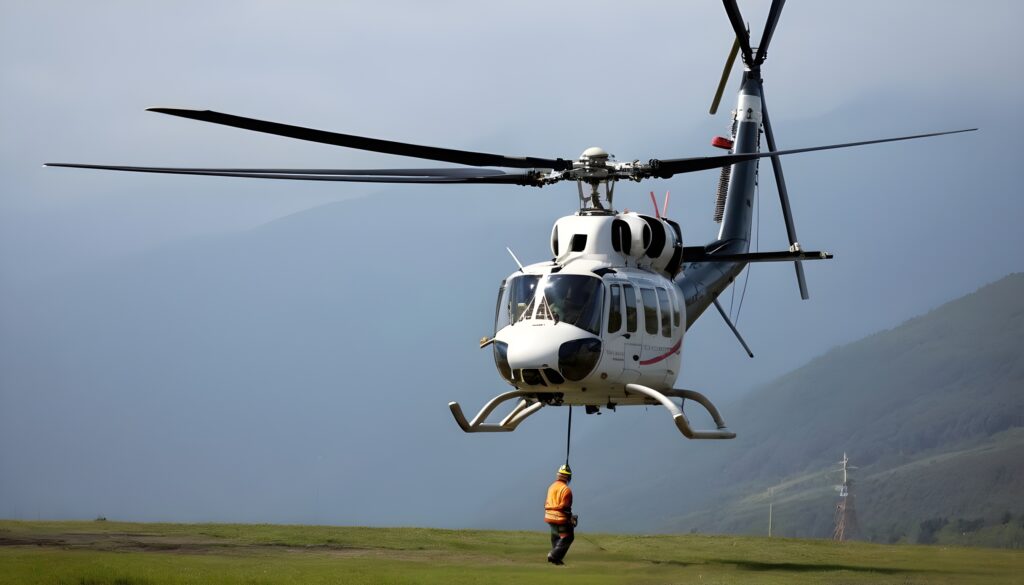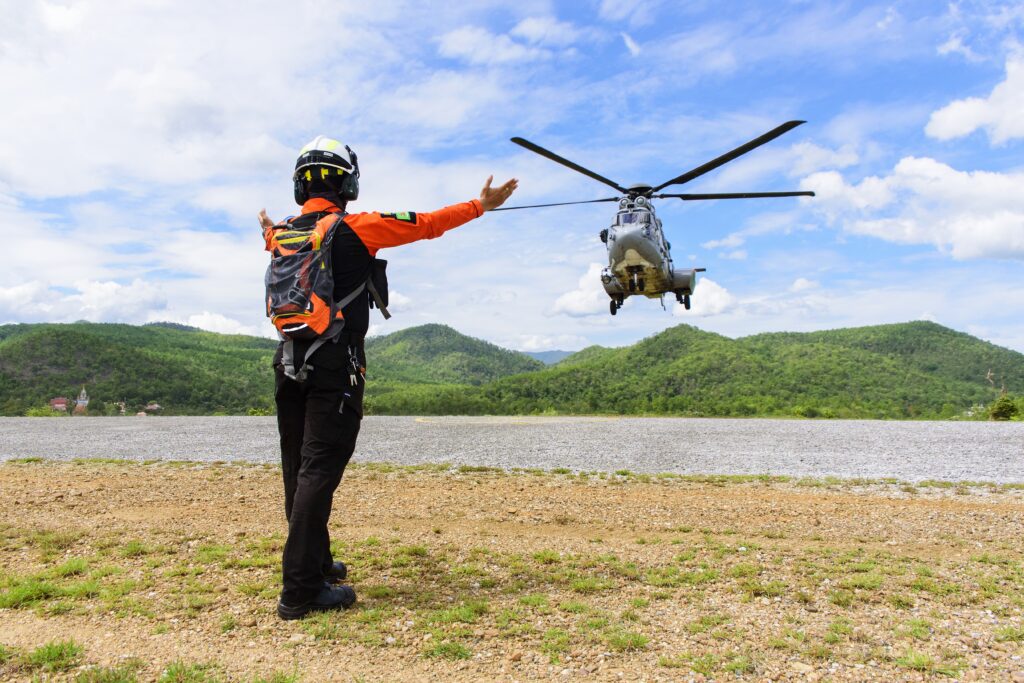A helicopter lineman installs and maintains power lines from a helicopter. Their job is high-risk and requires specialized training.
Helicopter linemen are critical in the maintenance and repair of electrical power systems, particularly in remote or difficult-to-reach areas. This high-stakes profession combines electrical knowledge with aviation skills to execute complex tasks at substantial heights, often while the lines are live to avoid power outages.
These skilled technicians undergo rigorous safety training to navigate the unique challenges of their aerial workplace. Their work ensures reliable electricity supply to homes and businesses, playing a vital role in the infrastructure of modern society. By swiftly addressing issues from mid-air, helicopter linemen help minimize disruption and maintain the essential flow of power.

Credit: illumination.duke-energy.com
Job Description
A Helicopter Lineman is a skilled professional. They maintain and repair electrical power systems. They work from a helicopter. They ensure our lights stay on. It’s a job for the brave and skilled.
Primary Responsibilities
- Inspecting power lines from the air.
- Repairing damaged equipment on high-voltage lines.
- Working closely with pilots to navigate to work sites.
- Ensuring adherence to all safety regulations.
- Communicating effectively with ground support crew.
- Using special tools while suspended from a helicopter.
Challenges Of The Job
Being a Helicopter Lineman isn’t easy. The job comes with significant risks. One must deal with extreme heights and high voltage. Weather conditions can be harsh. They must maintain focus above all else. The mental and physical demands are intense.
| Challenge | Explanation |
|---|---|
| Height | Working often at heights over 100 feet. |
| Electricity | Dealing with live electrical components. |
| Weather | Facing extreme conditions like storms or heat. |
| Concentration | Remaining attentive while in the air for hours. |
Helicopter Lineman Training
Helicopter Lineman Training prepares brave workers for a high-flying career. They fix power lines from the sky. Safety and skill are key. Training is tough but exciting. Let’s explore how these linemen become ready for the job.
Education And Certification
Starting education and certification is the first step. Aspiring linemen need:
- High school diploma or GED
- Technical school training for electrical basics
They also need special classes. These are for safety and first aid. After this, they get a certification. The Electrical Lineman Program is popular.
| Requirement | Details |
|---|---|
| Education | High school or equivalent |
| Additional Training | Technical school |
| Certification | E.g. Electrical Lineman Program |
On-the-job Training
On-the-job training is where real action begins. Trainees learn by doing. They work with experienced linemen. They also get to know the helicopters well.
- Hands-on experience with tools and equipment
- Flight safety practices
- Emergency procedures mastery
This training can last for years. It ensures skills are sharp and knowledge is deep.
Tools And Equipment Used
The role of a Helicopter Lineman may sound exhilarating, but it requires a specific set of tools and equipment to ensure tasks are accomplished efficiently and safely. To maintain and repair high-voltage power lines, these professionals rely on a mix of advanced technology and heavy-duty gear. Engage with the key tools and equipment that make the high-flying work of a helicopter lineman possible.
Helicopters
At the heart of their operation, helicopters are indispensable assets. Employed for rapid transit to towering work locations, these machines must be high-performance and well-maintained. They are designed for stability in a variety of weather conditions and equipped with customized attachments that help linemen complete their work. Key features include:
- Extended Range: Fuel efficiency and capacity for longer flights.
- Precision Hovering: State-of-the-art navigation systems for stable positioning.
- Custom Payloads: Adaptability for carrying necessary equipment and personnel.
Safety Equipment
No amount of technology can replace the critical importance of safety gear. Linemen use specialized equipment to protect themselves from the inherent dangers of their job. This includes:
| Equipment | Description |
|---|---|
| Insulated Gloves | For handling high-voltage lines safely. |
| Flame-resistant Clothing | To protect against arcs and flashes. |
| Safety Harness | A tether to prevent falls during aerial work. |
| Dielectric Boots | Footwear that insulates against electric shocks. |
| Hard Hats | Essential head protection from impact and electric hazards. |

Key Skills Required
Helicopter linemen perform one of the most exhilarating and demanding jobs in the world. This role requires a unique set of skills to ensure safety and efficiency while working on high-voltage power lines from above. Let’s break down the key abilities every helicopter lineman must possess.
Physical Fitness
Exceptional physical strength and endurance form the cornerstone of a helicopter lineman’s capabilities. Here’s why:
- Constantly climbs and maneuvers on structures.
- Works in a harness for extended periods.
- Handles heavy tools and equipment.
Stamina and agility are crucial when battling the elements at dizzying heights. Their fitness level ensures they can focus on the task without fatigue compromising safety.
Teamwork
No lineman works alone. Teamwork is a vital skill for these professionals. Their lives depend on perfect coordination with:
- Pilots, who navigate the chopper.
- Ground crews, who provide support.
- Other linemen, who maintain precise communication.
This collaborative approach is essential to execute complex tasks with precision. Together, they overcome challenges efficiently and safely.
Problem-solving Abilities
Helicopter linemen face unpredictable situations that require quick thinking. Problem-solving skills include:
- Analysing complex systems rapidly.
- Diagnosing issues under pressure.
- Implementing effective solutions.
The ability to swiftly identify and resolve issues is critical for preventing accidents and ensuring uninterrupted power supply.
Working Conditions
Let’s talk about working as a Helicopter Lineman. It is not a regular desk job! It’s filled with daily adventures and challenges. In this job, safety and flexibility rule. Brace yourself, as we dive into a day in the life of these high-flying professionals.
Work Schedule
Helicopter linemen often have unpredictable schedules. Their work is not the usual nine-to-five. They might work for long hours during emergency repairs. Their shifts can vary, and overtime is common. Think about a lineman swinging from the sky to keep the lights on at all hours!
Weather Considerations
The weather is a lineman’s boss and it can change in a heartbeat. Storms, winds, and extreme temperatures can make their work tough. They need to be ready for anything: snow, rain, or blazing sun. This job calls for courage and the right gear to stay safe up there.
Travel Requirements
Traveling is part of the deal for a Helicopter Lineman. They often move from site to site to fix power lines. Sometimes they stay away from home for days, or even weeks. They go wherever the job takes them, from remote areas to bustling cities.

Salary And Career Outlook
Exploring the Salary and Career Outlook for helicopter linemen reveals a profession that’s as daring as it is rewarding. These skilled individuals work on live high-voltage power lines from helicopters, ensuring our lights stay on. The financial and professional prospects in this field merit a closer look.
Salary Range
Helicopter lineman salaries depend on experience, location, and employer. Newcomers can expect to start in a generous pay bracket. Seasoned professionals can command even higher salaries. Many positions also offer overtime pay, which can significantly increase annual earnings.
| Experience Level | Average Salary |
|---|---|
| Entry-Level | $50,000 – $60,000 |
| Mid-Level | $70,000 – $80,000 |
| Experienced | $90,000+ |
Job Growth And Opportunities
The demand for helicopter linemen is rising steadily. This growth is due to expanding power grids and the need for constant maintenance. Opportunities extend beyond traditional utilities to emergency service providers and private contractors.
- Continuous training programs
- Path to leadership roles
- Diverse employment sectors
Job security in this role is high, partly due to the specialized skills required. For those willing to embrace the heights and challenges, a career as a helicopter lineman promises to be a lucrative and stable choice.
Frequently Asked Questions On Helicopter Lineman
How Much Do Helicopter Lineman Make In The Us?
Helicopter linemen in the US typically earn between $60,000 and $100,000 annually. Their salary varies based on experience, location, and the employing company.
What Is A Helicopter Lineman?
A helicopter lineman is a skilled technician who repairs and maintains power lines, often working from a helicopter. These professionals perform essential work at high altitudes to ensure electrical grid reliability.
How Do You Become A High Voltage Helicopter Lineman?
To become a high voltage helicopter lineman, obtain an electrical lineman certification and pursue specialized aerial lineman training. Gain experience in power line work and secure a role with a utility company or contractor that offers helicopter lineman services. Complete necessary flight safety programs.
What Does An Aerial Lineman Do?
An aerial lineman installs and repairs cables or wires used in electrical power or telecommunications systems. They often work on poles and towers, managing infrastructure high above ground.
Conclusion
The role of a helicopter lineman remains utterly crucial to our power grid’s resilience. They ensure consistent electricity flow and make rapid, high-altitude repairs possible. Their bravery and skill deserve our utmost respect. For those considering this career, it promises challenge, fulfillment, and an irreplaceable contribution to our everyday lives.
people also read

